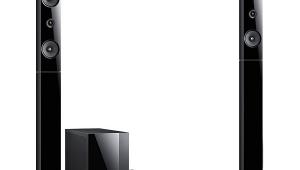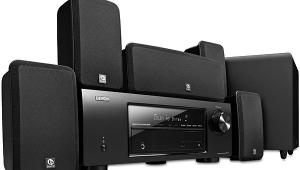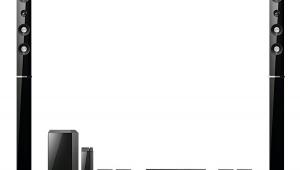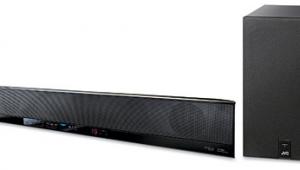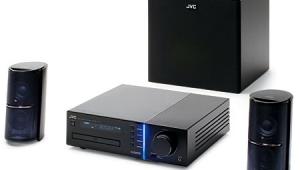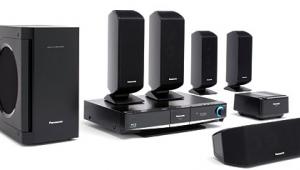Face Off: HTIB 4U
A home theater in a box? Can it really be that simple? Do you really get everything you need in one package? HTIBs are huge sellers. Some complete systems sell for less than $500, and others cost more than $2,500. We gathered three that fall somewhere in the middle: the JBL Cinema ProPack600, the Sony DAV-C900, and the Unity, codeveloped by Kenwood and Boston Acoustics. All three retail for $1,200, but you should be able to find them for a bit less. Promising free ice cream, I gathered the usual suspects to participate in the Face Off: audio editor Chris Lewis, executive editor Adrienne Maxwell, copy editor Claire Lloyd, and the ubiquitous Ron Williams, our technical consultant. Much was voiced about the ruse of free ice cream, which was a lie.
Setting up the systems was the tricky part. I wanted this to be a blind test until the end, when we judged each system's aesthetics and tallied that factor into the final vote. At each of the speaker locations, Mike Wood and I fashioned what can best be described as a speaker Susan (Mike calls it a "lazy Geoff"). To the lazy Susan's hardware, we bolted a round piece of particleboard, which we placed on a speaker stand at the proper listening height and distance. By setting up the HTIB speakers this way, we could switch them out with the ease of a Sit-and-Spin. From the ceiling, we hung a thin layer of black, acoustically transparent cloth in front of the speakers and equipment to hide them from view. All that was missing was a glow-in-the-dark skeleton and spooky music for it to pass as a haunted house. For movies, we used our reference Princeton AF3.0HD monitor. Mike and I set each system's levels with its internal test tones. This worked fine, except with the JBL HTIB, which had internal test tones for every channel but the sub. This would come back to haunt the system. After we set each system's levels, we set a universal volume so as not to give an unfair advantage to a louder system. We came close, but the levels were slightly off. A bit later, I'll discuss what we did to counteract this discrepancy, and you'll see that it really didn't matter too much in the final tally.
Behind the black shroud of secrecy were our contenders. The first was the JBL Cinema ProPack600, which had the smallest speakers and the largest electronics. The 135SAT satellite is about the size of a fist, and the 135CEN center channel is about twice that. Each has a 0.5-inch dome tweeter and a 3-inch midrange driver (the center has two midrange drivers). The SUB135S has 100 watts driving an 8-inch woofer in a bass-reflex enclosure that measures a little over a cubic foot. This system is similar to the Harman/Kardon HKTS 2 that I reviewed in the October 2001 issue, but with a smaller sub. The electronics are where this product differs the most from the other HTIBs in this Face Off. The receiver and the DVD player are separate components, and each functions independently of the other.
The DCR600 receiver has 78.8 watts into 8 ohms at 1 percent THD (see the measurements box), which is twice as high as the next closest contender, the Unity. As an added bonus, Harman's Logic7 surround processing is included. The receiver has three digital inputs (one optical and two coax), two digital outputs (one optical and one coax), five stereo inputs, and three stereo outputs. On the video side, there are four video inputs with either composite or Y/C (S-video). One monitor output is joined by another video out, both with composite and Y/C connections. For the speakers, there are five regular speaker posts and a standard RCA-style connector for the subwoofer. On the front are a stereo audio, a composite, and a Y/C connection, as well as an optical input and a coax in/output.
The DVD600 is a five-disc DVD/CD changer with only a coax connection for the audio but composite, Y/C, and Y/Pb/Pr plugs for the video. As is the case with several of the latest Harman/Kardon products we've reviewed, there will be a new Cinema ProPack model by the time you read this. More on that later.
The second HTIB in our Face Off is the Sony DAV-C900. Sleek and stylish in its brushed-metal skin, the Sony is a real looker. Each SS-TS550 front speaker and SS-RS550 rear has two 2.375-inch woofers, while the SS-CT550 center has two 2-inch woofers. All have the same single 0.625-inch dome tweeter. The SS-WS550 sub has an 8-inch driver that's powered off the main unit. The HCD-C900 contains all of the electronics and is rated at 31.3 watts per channel into 8 ohms at 1 percent THD (see the measurements box)—the lowest of the bunch. Its five-disc changer is the only one in the group that plays SACDs in addition to DVDs and CDs.
There's a bare minimum of connections on the back, including two stereo inputs, one optical digital in, and one optical digital out. Two composite video inputs and one composite output round out the unit's receiver connections. The DVD-player side has composite, Y/C, and Y/Pb/Pr connections for the video. The speaker terminals use color-coded Molex-type plastic connectors. While this makes setup a breeze (the speakers have color-coded labels, as well), any hope of upgrading the speaker wires without soldering is dashed.
The third HTIB is the Kenwood/Boston Acoustics Unity. Not quite as stunning as the Sony, the Unity still holds its own in the looks department. Made by Boston Acoustics, the satellite has a 0.75-inch tweeter and a 3-inch woofer. Despite the cloth front that makes it look like a front-firing sub, the 100-watt U1 sub has a down-firing 8-inch driver.
- Log in or register to post comments
